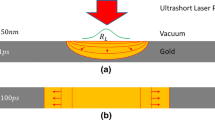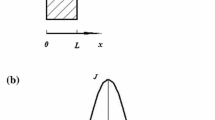Abstract
Analytical solution for electron and lattice temperature distribution in the solid initially heated by a laser short-pulse is presented. Strained parameters method is introduced when formulating electron and lattice temperature distributions. Laser short pulse heating of gold film is simulated numerically and temperature data at the end of the heating pulse are adopted as initial condition to the governing equations of energy transport for analytical solutions. This enables to solve the governing equations of energy analytically in the cooling period. It is found that electron temperature decays sharply while lattice site temperature increases gradually in the surface regions during the cooling cycle. As the depth from the surface increases change in both temperatures become gradual.








Similar content being viewed by others
Abbreviations
- C e :
-
Electron specific heat capacity, J/m3 K
- C l :
-
Lattice site specific heat capacity, J/m3 K
- d:
-
= \(\frac{1} {\lambda }\), 1/m
- G:
-
Electron–phonon coupling factor, W/m3 K
- I 0 :
-
Peak power intensity, W/m2
- k :
-
Thermal conductivity, W/mK
- L :
-
Film thickness, m
- m e :
-
Electron mass, kg
- N :
-
Electron number density, 1/m3
- r f :
-
Surface reflectivity
- t :
-
= \( \frac{{\bar t}}{{C_{\text{e}} /G}} \)
- \({\bar t}\) :
-
time, s
- T e :
-
Electron temperature, K
- T l :
-
Lattice site temperature, K
- T o :
-
Reference temperature, K
- \({\bar V}\) :
-
Electron mean velocity, m/s
- x:
-
\( =\bar x\;d\)
- \({\bar x}\) :
-
Distance along the x-axis, m
- δ:
-
Absorption depth, (1/m)
- α:
-
=\( \frac{{kd^2 }}{G}\)
- ε :
-
= \( \frac{{C_{\text{e}} }} {{C_l }}\)
- λ:
-
Electron mean free path, m
- θ e :
-
= \( \frac{{T_{\text{e}} }}{{T_o }}\)
- θ l :
-
= \( \frac{{T_l }}{{T_o }}\)
- τ s:
-
Electron mean free time between electron and phonon coupling, s
References
Elsayed-Ali HE, Norris TB, Pessot MA, Mourou GA (1987) Time-resolved observation of electron-phonon relaxation in copper. Phys Rev Lett 58:1212–1215
Brorson SD, Kazeroonian A, Moodera JS, Face DW, Cheng TK, Ippen EP, Dresselhaus MS, Dresselhaus G (1990) Femtosecond room-temperature measurement of the electron-phonon coupling constant λ in metallic superconductors. Phys Rev Lett 64:2172–2175
Fujimoto JG, Liu JM, Ippen EP (1984) Femtosecond laser interaction with metallic tungsten and nonequilibrium electron and lattice temperatures. Phys Rev Lett 53:1837–1840
Eesley GL (1986) Generation of nonequilibrium electron and lattice temperatures in copper by picosecond laser pulses. Phys Rev B 33:2144–2151
Qiu TQ, Tien CL (1992) Short-pulse laser heating on metals. Int J Heat Mass Transfer 35:719–726
Tzou DY (1995) A unified field approach for heat conduction from macro-to-micro-scales. ASME J Heat Transfer 117:8–16
Honner M, Kunnes J (1999) On the wave diffusion and parallel nonequilibrium heat conduction. ASME J Heat Transfer 121:702–707
Chen G (2001) Ballistic-diffusive heat-conduction equations. Phys Rev Lett 86:2297–2300
Allen PB (1987) Theory of relaxation of electrons in metals. Phys Rev Lett 13:1460–1463
Lin C, Hwang C, Chang Y (1997) The unsteady solutions of a unified heat conduction equation. Int J Heat Mass Transfer 40:1716–1719
Yilbas BS (1986) Heating of metals at a free surface by laser radiation an electron kinetic theory approach. Int J Eng Sci 24(8):1325–1334
Yilbas BS (2001) Electron kinetic theory approach—one- and three-dimensional heating with pulsed laser. Int Heat Mass Transfer 44:1925–1936
Yilbas BS (2001) Electron kinetic theory approach for picosecond laser pulse heating. Num Heat Transfer 39:823–845
Yilbas BS (2001) Electron kinetic theory approach for picosecond laser pulse heating. Num Heat Transfer 39:823–845
Nayfeh AH (1981) Introduction to perturbation techniques. Wiley, New York
Yilbas BS, Shuja SZ, Budair MO (2000) Nano-second pulse heating and gas assisting jet considerations. Int J Machine Tools Manuf 40:1023–1038
Shuja SZ, Yilbas BS, Budair MO (1998) Modeling of laser heating of solid substance including assisting gas impingement. Num Heat Transfer A 33:315–339
Acknowledgements
The authors acknowledge the support of King Fahd University of Petroleum and Minerals, Dhahran, Saudi Arabia for this work.
Author information
Authors and Affiliations
Corresponding author
Rights and permissions
About this article
Cite this article
Yilbas, B.S., Pakdemirli, M. & Mansoor, S.B. Analytical solution for temperature field in thin film initially heated by a short-pulse laser source. Heat Mass Transfer 41, 1077–1084 (2005). https://doi.org/10.1007/s00231-004-0607-4
Received:
Accepted:
Published:
Issue Date:
DOI: https://doi.org/10.1007/s00231-004-0607-4




